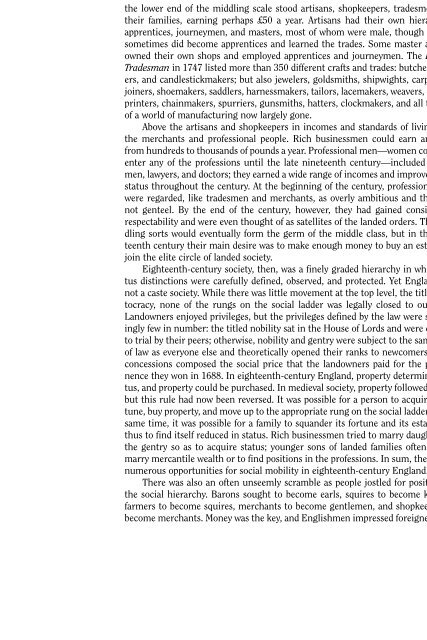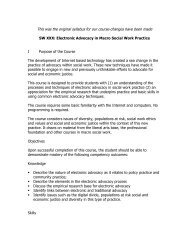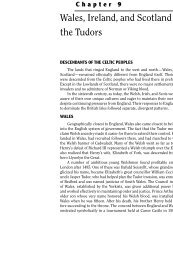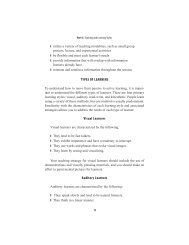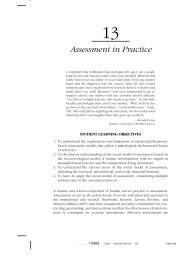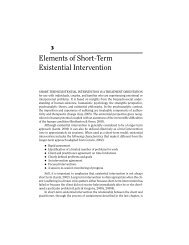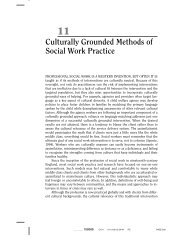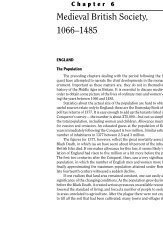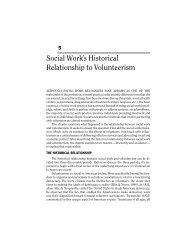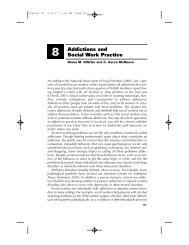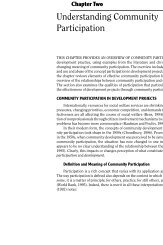Society and Economy in England, 1715–1763 - Lyceum Books
Society and Economy in England, 1715–1763 - Lyceum Books
Society and Economy in England, 1715–1763 - Lyceum Books
You also want an ePaper? Increase the reach of your titles
YUMPU automatically turns print PDFs into web optimized ePapers that Google loves.
50 Part I The Age of the L<strong>and</strong>ed Oligarchy<br />
the lower end of the middl<strong>in</strong>g scale stood artisans, shopkeepers, tradesmen, <strong>and</strong><br />
their families, earn<strong>in</strong>g perhaps £50 a year. Artisans had their own hierarchies:<br />
apprentices, journeymen, <strong>and</strong> masters, most of whom were male, though women<br />
sometimes did become apprentices <strong>and</strong> learned the trades. Some master artisans<br />
owned their own shops <strong>and</strong> employed apprentices <strong>and</strong> journeymen. The London<br />
Tradesman <strong>in</strong> 1747 listed more than 350 different crafts <strong>and</strong> trades: butchers, bakers,<br />
<strong>and</strong> c<strong>and</strong>lestickmakers; but also jewelers, goldsmiths, shipwights, carpenters,<br />
jo<strong>in</strong>ers, shoemakers, saddlers, harnessmakers, tailors, lacemakers, weavers, cutlers,<br />
pr<strong>in</strong>ters, cha<strong>in</strong>makers, spurriers, gunsmiths, hatters, clockmakers, <strong>and</strong> all the rest<br />
of a world of manufactur<strong>in</strong>g now largely gone.<br />
Above the artisans <strong>and</strong> shopkeepers <strong>in</strong> <strong>in</strong>comes <strong>and</strong> st<strong>and</strong>ards of liv<strong>in</strong>g were<br />
the merchants <strong>and</strong> professional people. Rich bus<strong>in</strong>essmen could earn anyth<strong>in</strong>g<br />
from hundreds to thous<strong>and</strong>s of pounds a year. Professional men—women could not<br />
enter any of the professions until the late n<strong>in</strong>eteenth century—<strong>in</strong>cluded clergymen,<br />
lawyers, <strong>and</strong> doctors; they earned a wide range of <strong>in</strong>comes <strong>and</strong> improved their<br />
status throughout the century. At the beg<strong>in</strong>n<strong>in</strong>g of the century, professional men<br />
were regarded, like tradesmen <strong>and</strong> merchants, as overly ambitious <strong>and</strong> therefore<br />
not genteel. By the end of the century, however, they had ga<strong>in</strong>ed considerable<br />
respectability <strong>and</strong> were even thought of as satellites of the l<strong>and</strong>ed orders. The middl<strong>in</strong>g<br />
sorts would eventually form the germ of the middle class, but <strong>in</strong> the eighteenth<br />
century their ma<strong>in</strong> desire was to make enough money to buy an estate <strong>and</strong><br />
jo<strong>in</strong> the elite circle of l<strong>and</strong>ed society.<br />
Eighteenth-century society, then, was a f<strong>in</strong>ely graded hierarchy <strong>in</strong> which status<br />
dist<strong>in</strong>ctions were carefully def<strong>in</strong>ed, observed, <strong>and</strong> protected. Yet Engl<strong>and</strong> was<br />
not a caste society. While there was little movement at the top level, the titled aristocracy,<br />
none of the rungs on the social ladder was legally closed to outsiders.<br />
L<strong>and</strong>owners enjoyed privileges, but the privileges def<strong>in</strong>ed by the law were surpris<strong>in</strong>gly<br />
few <strong>in</strong> number: the titled nobility sat <strong>in</strong> the House of Lords <strong>and</strong> were entitled<br />
to trial by their peers; otherwise, nobility <strong>and</strong> gentry were subject to the same body<br />
of law as everyone else <strong>and</strong> theoretically opened their ranks to newcomers. These<br />
concessions composed the social price that the l<strong>and</strong>owners paid for the preem<strong>in</strong>ence<br />
they won <strong>in</strong> 1688. In eighteenth-century Engl<strong>and</strong>, property determ<strong>in</strong>ed status,<br />
<strong>and</strong> property could be purchased. In medieval society, property followed status,<br />
but this rule had now been reversed. It was possible for a person to acquire a fortune,<br />
buy property, <strong>and</strong> move up to the appropriate rung on the social ladder. At the<br />
same time, it was possible for a family to squ<strong>and</strong>er its fortune <strong>and</strong> its estates <strong>and</strong><br />
thus to f<strong>in</strong>d itself reduced <strong>in</strong> status. Rich bus<strong>in</strong>essmen tried to marry daughters of<br />
the gentry so as to acquire status; younger sons of l<strong>and</strong>ed families often had to<br />
marry mercantile wealth or to f<strong>in</strong>d positions <strong>in</strong> the professions. In sum, there were<br />
numerous opportunities for social mobility <strong>in</strong> eighteenth-century Engl<strong>and</strong>.<br />
There was also an often unseemly scramble as people jostled for positions <strong>in</strong><br />
the social hierarchy. Barons sought to become earls, squires to become knights,<br />
farmers to become squires, merchants to become gentlemen, <strong>and</strong> shopkeepers to<br />
become merchants. Money was the key, <strong>and</strong> Englishmen impressed foreigners with


